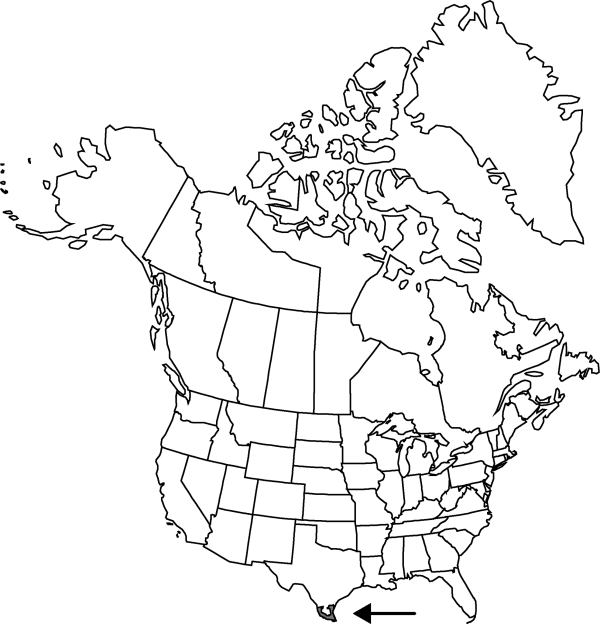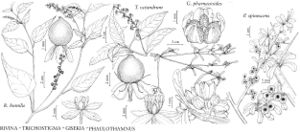Difference between revisions of "Phaulothamnus spinescens"
Proc. Amer. Acad. Arts 20: 294. 1885.
Common names: Snake-eyes putia
FNA>Volume Importer |
FNA>Volume Importer |
||
| Line 17: | Line 17: | ||
}}<!-- | }}<!-- | ||
| − | --><span class="statement" id="st- | + | --><span class="statement" id="st-undefined" data-properties=""><b>Plants </b>erect, to 2.5 m, glabrous. <b>Leaves</b> sessile or petiolate; blade to 35 × 12 mm, broadest distal to middle; petiole ± 1 mm. <b>Flowers</b> yellow-green; tepals 4, 2.5 × 2 mm. <b>Berries</b> gray-translucent to white, tinged with green, borne on peduncle 0.5–2 × 4–5 mm diam. <b>Seed</b> black, 1–2 mm, granular and rugose, visible through fruit wall.</span><!-- |
-->{{Treatment/Body | -->{{Treatment/Body | ||
| + | |phenology=Flowering summer–fall; fruiting fall–winter. | ||
|habitat=Sandy to clayey soils in thickets, wooded areas | |habitat=Sandy to clayey soils in thickets, wooded areas | ||
|elevation=0-200 m | |elevation=0-200 m | ||
| Line 39: | Line 40: | ||
|basionyms= | |basionyms= | ||
|family=Achatocarpaceae | |family=Achatocarpaceae | ||
| + | |phenology=Flowering summer–fall; fruiting fall–winter. | ||
|habitat=Sandy to clayey soils in thickets, wooded areas | |habitat=Sandy to clayey soils in thickets, wooded areas | ||
|elevation=0-200 m | |elevation=0-200 m | ||
| Line 46: | Line 48: | ||
|publication year=1885 | |publication year=1885 | ||
|special status= | |special status= | ||
| − | |source xml=https://jpend@bitbucket.org/aafc-mbb/fna- | + | |source xml=https://jpend@bitbucket.org/aafc-mbb/fna-data-curation.git/src/9216fc802291cd3df363fd52122300479582ede7/coarse_grained_fna_xml/V4/V4_23.xml |
|genus=Phaulothamnus | |genus=Phaulothamnus | ||
|species=Phaulothamnus spinescens | |species=Phaulothamnus spinescens | ||
| − | |||
| − | |||
| − | |||
| − | |||
| − | |||
| − | |||
| − | |||
| − | |||
| − | |||
| − | |||
| − | |||
| − | |||
| − | |||
| − | |||
| − | |||
| − | |||
| − | |||
| − | |||
| − | |||
}}<!-- | }}<!-- | ||
-->[[Category:Treatment]][[Category:Phaulothamnus]] | -->[[Category:Treatment]][[Category:Phaulothamnus]] | ||
Revision as of 14:00, 27 July 2019
Plants erect, to 2.5 m, glabrous. Leaves sessile or petiolate; blade to 35 × 12 mm, broadest distal to middle; petiole ± 1 mm. Flowers yellow-green; tepals 4, 2.5 × 2 mm. Berries gray-translucent to white, tinged with green, borne on peduncle 0.5–2 × 4–5 mm diam. Seed black, 1–2 mm, granular and rugose, visible through fruit wall.
Phenology: Flowering summer–fall; fruiting fall–winter.
Habitat: Sandy to clayey soils in thickets, wooded areas
Elevation: 0-200 m
Distribution

Tex., Mexico (Baja California, Nuevo León, Sonora, Tamaulipas).
Discussion
Phaulothamnus spinescens is very infrequent, scattered in the lower south Texas plains and adjacent Mexico. Because the seeds are black and easily seen within the translucent fruits, the fruits give the appearance of a small eye, hence the common name snake-eyes.
Selected References
None.
Lower Taxa
None.
